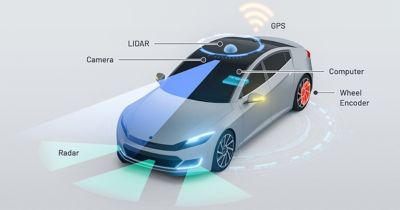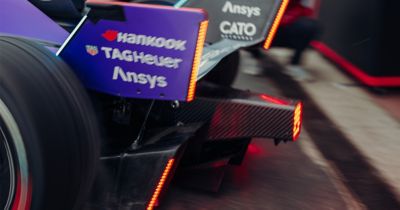-
United States -
United Kingdom -
India -
France -
Deutschland -
Italia -
日本 -
대한민국 -
中国 -
台灣
-
-
產品系列
查看所有產品Ansys致力於為當今的學生打下成功的基礎,通過向學生提供免費的模擬工程軟體。
-

車輛照明技術在過去幾十年來經歷了重大的發展。從簡單的白熾燈泡開始,發展到複雜的發光二極體 (LED) 系統、自適應照明,甚至是全數位照明解決方案。隨著汽車產業轉向更強大的連線能力、自動駕駛和電動車發展,對創新照明解決方案的需求也比以往任何時候都更高。Ansys 處於這場革命的前沿,尤其是其先進的 Ansys Optics 產品套件,包括 Ansys Lumerical 求解器、Ansys Speos CAD 整合光學與照明模擬軟體,以及 Ansys Zemax OpticStudio 光學系統設計與分析軟體。

車輛照明的演進
從白熾燈到 LED 燈
車輛照明的發展之旅始於基本的白熾燈泡。這種燈泡簡單可靠,但效率或耐用度不是很高。1960 年代推出的鹵素燈提升了亮度和使用壽命。然而,直到 LED 技術的問世,車輛照明才出現大幅改變。
LED 帶來多項優勢:可節能、使用壽命更長,並提供更大的設計彈性。這種彈性使汽車製造商能夠進行照明設計實驗,將其整合到車輛的整體美學和功能設計當中。
自適應照明及更先進的技術
車輛照明的下一個重大飛躍是自適應照明系統的開發。這些系統通常與車輛的感應器和攝影機整合,可以根據駕駛條件調整光束的方向、強度和擴散。例如,自適應頭燈可在車輛轉彎時旋轉以照亮前方道路,或根據交通狀況自動切換遠光燈和近光燈。
電動車 (EV) 和自動駕駛車輛 (AV) 的興起,進一步突破車輛照明技術的極限。相較於傳統的內燃機車輛,電動車的設計限制較少,因此提供更多創新照明解決方案的機會。另一方面,自動駕駛車輛嚴重依賴先進的感應器系統,其中許多感應器系統可以與照明系統整合,以增強車輛安全性,並與其他道路使用者通訊。

車輛照明的未來:關鍵趨勢
數位照明系統
數位照明將改變汽車產業。這些系統使用微型 LED 或有機發光二極體 (OLED) 來建立複雜的照明模式和動畫。數位照明可以增強車輛通訊,例如透過將訊號或訊息投射到道路上,以與行人和其他車輛互動。在我們邁向更高的車輛自主性時,這一點至關重要,因為此時車輛與其周圍環境之間的清晰溝通至關重要。
雷射和矩陣照明
雷射照明和矩陣 LED 系統代表著最先進的車輛頭燈技術。雷射頭燈提供比傳統 LED 燈更高的亮度和範圍,可在較高的速度和較差的能見度條件下提升駕駛安全性。另一方面,矩陣 LED 系統由 LED 陣列組成,可單獨控制以建立精確的照明模式。這樣可以更好地控制光線分佈,最大限度地減少迎面駕駛的眩光,同時將道路照明最大化。
擴增實境和抬頭顯示器
車輛中的擴增實境 (AR) 是照明技術扮演關鍵角色的另一個令人興奮的領域。AR 抬頭顯示器 (HUD) 會將重要的駕駛資訊直接投影到擋風玻璃上,讓駕駛的視線無須離開道路即可取得這些資料。未來的 AR 系統可以與先進照明解決方案整合,例如將導航提示投影到道路上,或即時強調潛在危險。

Ansys Optics:推動車輛照明的創新
全面的模擬工具
Ansys Optics 提供一套全面的模擬工具,讓汽車工程師能夠在虛擬環境中設計、測試和最佳化車輛照明系統。這些工具涵蓋從個別元件的光學設計,到照明系統與整體車輛設計的整合等一切。
使用 Ansys Optics 產品系列功能的主要優勢之一,是能夠以高準確度模擬真實環境。工程師可以測試不同的照明設計在多種駕駛條件下的表現,例如不同的天氣條件、道路類型和交通情境。這有助於確保照明系統不僅符合法規要求,還能在現實情況中提供最佳效能。
支援先進照明技術
Ansys Optics 特別適合開發先進照明技術,例如矩陣 LED、雷射燈和數位照明系統。此產品系列可讓工程師模擬光線與不同材料之間的複雜交互作用,包括光線如何被反射、折射和吸收。這對於最佳化這些先進照明系統的性能並確保它們提供所需的照明效果而言至關重要。
例如,在矩陣 LED 系統中,Ansys Optics 產品可以模擬每個 LED 如何與周圍的光學元素互動,以產生精準的照明模式。這種詳細程度對於開發可根據駕駛環境動態調整光線分佈的自適應照明系統而言是不可或缺的。
與自動駕駛車輛系統整合
隨著車輛的自動駕駛能力越來越強,照明系統與車輛感應器套件之間的整合將變得越來越重要。Ansys Optics 提供工具模擬照明如何與車輛攝影機、光學雷達和其他感應器相互作用,進而支援這項整合。這有助於確保照明系統能增強這些感應器的效能,而非干擾它們。
例如,Ansys Optics 產品可用於模擬不同的照明條件如何影響車輛攝影機和光學雷達系統的效能。這對於確保自動駕駛車輛能夠準確偵測並回應周圍環境至關重要,即使是在具挑戰性的照明條件下也是如此。
虛擬原型設計和測試
Ansys Optics 產品的主要優點之一,是能夠支援虛擬原型設計和測試。這使汽車工程師能夠在投入使用實體原型之前,在虛擬環境中測試照明設計。這不僅加快開發過程,還透過最大限度地減少對昂貴實體原型的需求來降低成本。
此外,Ansys Optics 支援數位孿生的開發,亦即實體照明系統的虛擬複本。這些數位孿生可用於即時監控照明系統的效能,在車輛的整個生命週期中實現預測性維護和最佳化。

更聰明、更安全的未來
車輛照明的未來光明燦爛,先進技術 (例如數位照明、矩陣 LED 和 AR HUD) 將徹底改變駕駛體驗。隨著汽車產業的持續發展,對車輛照明系統的需求也隨之增加。透過實現全方位的模擬、虛擬原型設計以及與自動駕駛車輛系統的整合,Ansys Optics 能協助確保未來的車輛不僅更安全、更有效率,而且更具連線能力和智慧功能。
無論您是汽車工程師、設計師,或僅僅是技術愛好者,車輛照明的進步都是值得觀察的有趣發展,讓我們邁向更聰明、更安全、更令人眼睛一亮的汽車未來。
如需深入瞭解,請造訪 Ansys Optics。














